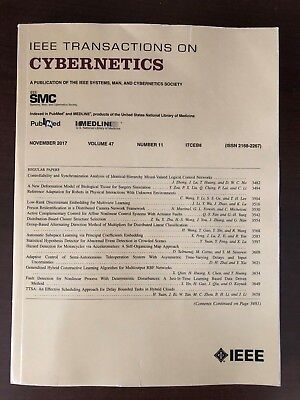Two-Layer Asynchronous Control for a Class of Nonlinear Jump Systems: An Interval Segmentation Approach
IF 9.4
1区 计算机科学
Q1 AUTOMATION & CONTROL SYSTEMS
引用次数: 0
Abstract
This article proposes the two-layer asynchronous control scheme for a class of networked nonlinear jump systems. For the constructed system in a network environment, the data transmission may suffer from many restrictions, such as incomplete acceptable mode information and transition information, nonlinearity of system and inadequate bandwidth resources, etc. Then, the two-layer asynchronous controller is developed to stabilize the plant constructed by Takagi-Sugeno (T-S) fuzzy method and semi-Markov theory (SMT). Herein, the hidden semi-Markov process with time-varying emission probability is introduced to establish the relation between the system modes and the controller modes, in which the interval segmentation method is presented to deal with this time-varying probability. Compared with some published results, this method can make full use of the transition rate information, which may lead to the reduction of conservatism in the proposed asynchronous control design. At the same time, the limited bandwidth problem in the communication channel is addressed by introducing the bilateral quantization strategy, and the new sufficient conditions are derived on the stochastic stability of the nonlinear jump system with/without incomplete transition and sojourn-time information. Finally, the numerical simulation examples about DC motor illustrate the effectiveness and the feasibility of the proposed approach.一类非线性跳跃系统的两层异步控制:区间分割方法
本文提出了一类网络非线性跃变系统的两层异步控制方案。对于在网络环境下构建的系统,数据传输可能会受到许多限制,如可接受模式信息和转换信息不完整、系统非线性和带宽资源不足等。然后,开发了两层异步控制器来稳定由Takagi-Sugeno (T-S)模糊方法和半马尔可夫理论(SMT)构造的对象。在此基础上,引入具有时变发射概率的隐半马尔可夫过程来建立系统模式与控制器模式之间的关系,并提出区间分割方法来处理这一时变概率。与已有的研究结果相比,该方法可以充分利用转换率信息,降低了异步控制设计的保守性。同时,通过引入双边量化策略,解决了通信信道中带宽有限的问题,并给出了具有/不具有不完全跃迁和逗留时间信息的非线性跃变系统的随机稳定性的新的充分条件。最后,通过直流电机的数值仿真实例验证了该方法的有效性和可行性。
本文章由计算机程序翻译,如有差异,请以英文原文为准。
求助全文
约1分钟内获得全文
求助全文
来源期刊

IEEE Transactions on Cybernetics
COMPUTER SCIENCE, ARTIFICIAL INTELLIGENCE-COMPUTER SCIENCE, CYBERNETICS
CiteScore
25.40
自引率
11.00%
发文量
1869
期刊介绍:
The scope of the IEEE Transactions on Cybernetics includes computational approaches to the field of cybernetics. Specifically, the transactions welcomes papers on communication and control across machines or machine, human, and organizations. The scope includes such areas as computational intelligence, computer vision, neural networks, genetic algorithms, machine learning, fuzzy systems, cognitive systems, decision making, and robotics, to the extent that they contribute to the theme of cybernetics or demonstrate an application of cybernetics principles.
 求助内容:
求助内容: 应助结果提醒方式:
应助结果提醒方式:


